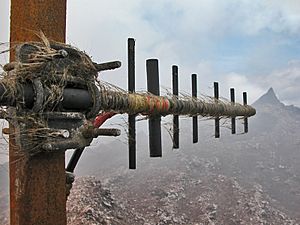Volcanology facts for kids
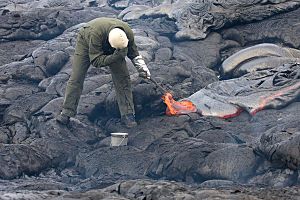
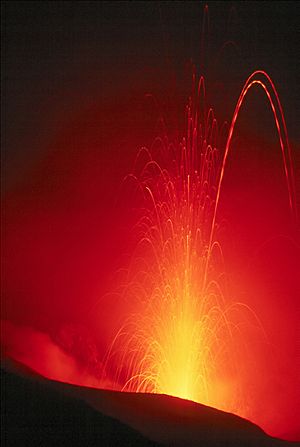
Volcanology is the study of volcanoes, lava, magma, and all the things connected to them, like how they form and what happens when they erupt. The word "volcanology" comes from the Latin word vulcan. In ancient Roman mythology, Vulcan was the god of fire.
A volcanologist is a scientist who studies volcanoes. They look at how volcanoes erupt and how they were formed. They also study past and present eruptions. Volcanologists often visit volcanoes, especially active ones, to watch eruptions and collect samples. These samples can include tephra (like ash or pumice), rocks, and lava. A big goal for volcanologists is to predict when a volcano will erupt. While it's hard to do this perfectly, predicting eruptions, like predicting earthquakes, could save many lives.
Contents
How Scientists Study Volcanoes Today
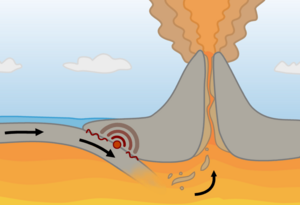
The first place built just for studying volcanoes was the Vesuvius Observatory. It was opened in Italy in 1841.
Scientists use many tools to keep an eye on volcanoes:
- Watching for Earthquakes: They use special tools called seismographs near volcanoes. These tools listen for small earthquakes, especially a type called "harmonic tremors." These tremors can mean that magma (melted rock) is moving underground.
- Measuring Ground Changes: Volcanologists measure how the ground around a volcano moves or changes shape. They use tools like tiltmeters and GPS. If the ground bulges up, it can mean that magma is rising closer to the surface.
- Checking Gases: They also check the gases coming out of volcanoes, like sulfur dioxide. A change in the amount or type of gas can be a sign that an eruption is coming.
- Monitoring Temperature: Scientists use thermometers to check the temperature of volcanic lakes and vents. Changes in temperature can also show that activity is increasing.
- Using Satellites: Satellites are very helpful because they can watch large areas from space. They can track how far ash clouds spread, like the one from Eyjafjallajökull's eruption in 2010. Satellites can also measure gas emissions and see ground changes in places that are hard to reach.
- Other Methods: Scientists also use other methods, like checking electrical signals, gravity, and magnetic patterns. These can show changes underground caused by magma moving.
- Studying Past Eruptions: By looking at layers of old ash and lava, scientists can learn about a volcano's past eruptions. This helps them understand how often a volcano erupts and how big those eruptions might be.
A Look Back at Volcanology
The study of volcanoes has a long history. One of the oldest pictures of a volcanic eruption might be a wall painting from about 7,000 BCE. It was found in Turkey and seems to show a volcano erupting with houses below it. The volcano might be Mount Hasan.
Ancient Ideas About Volcanoes
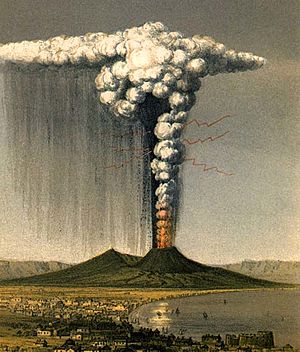
In ancient Greece and Rome, people often thought volcanoes were linked to their gods.
- The Greeks believed that Hephaestus, the god of fire, lived under Mount Etna and made weapons for Zeus.
- The Roman poet Virgil wrote that the giant Enceladus was buried under Etna by the goddess Athena. He said the volcano's rumblings were Enceladus's cries, and the flames were his breath.
- The Greek philosopher Empedocles (around 490-430 BCE) thought volcanoes were a sign of the element Fire.
- Plato believed that a huge river of fire, called the Pyriphlegethon, flowed deep underground and fed all volcanoes.
- Aristotle thought underground fire came from wind rubbing in narrow passages.
People believed wind was important for volcanoes until the 16th century. Lucretius, a Roman philosopher, thought Etna was hollow and fierce winds caused its fires. Pliny the Elder noticed that earthquakes often happened before an eruption. He died while investigating the eruption of Mount Vesuvius in 79 CE. His nephew, Pliny the Younger, wrote detailed descriptions of this eruption. Today, eruptions that are very explosive and produce large ash columns are called Plinian eruptions, named after these two authors.
New Observations in the Renaissance
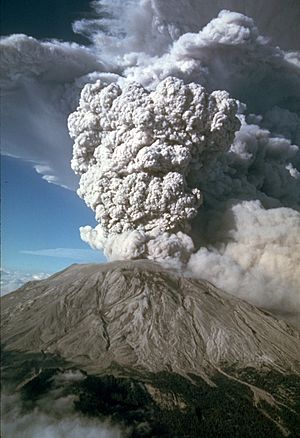
During the Renaissance, scientists started to look for more scientific explanations.
- Georgius Agricola (a German scientist) believed that vapor under pressure caused eruptions.
- A Jesuit priest named Athanasius Kircher (1602–1680) saw eruptions of Etna and Stromboli. He thought the Earth had a central fire connected to other fires caused by burning sulfur and coal.
- Johannes Kepler (a famous astronomer) thought volcanoes were like vents for the Earth's "tears and waste."
- René Descartes (a French philosopher) believed volcanoes formed where the sun's rays pierced the Earth.
At the time, all known volcanoes were near water. This led some to believe that the sea's action on the land caused volcanoes.
Volcanoes and Beliefs
Many cultures have legends about volcanoes, often involving gods or spirits.
- The Māori people of New Zealand have a story about Taranaki and Tongariro being lovers who fought over another mountain.
- In Hawaiian religion, Pele is the goddess of volcanoes. Many volcanic features are named after her, like Pele's hair (thin strands of volcanic glass) and Pele's tears (small drops of volcanic glass). A volcano on Jupiter's moon Io is also named Pele.
- Saint Agatha is the patron saint of Catania, a city near Mount Etna in Italy. People believed she helped stop an eruption of Etna in 253 CE. Even after a huge eruption in 1169 destroyed Catania, people continued to pray to her for protection from the volcano.
- In 1660, an eruption of Vesuvius dropped crystals that looked like crucifixes on nearby villages. People thought this was a miracle from Saint Januarius. In Naples, people still parade the relics of St. Januarius through town during major Vesuvius eruptions.
Famous Volcanologists
Many people have dedicated their lives to studying volcanoes:
- Pliny the Elder (23–79 AD) and Pliny the Younger (61 – about 113 AD): Roman authors who described the 79 CE eruption of Vesuvius.
- James Hutton (1726–1797): Often called the "Father of Modern Geology."
- Giuseppe Mercalli (1850–1914): Developed the Mercalli intensity scale for earthquakes.
- Thomas Jaggar (1871–1953): Started the Hawaiian Volcano Observatory.
- Haroun Tazieff (1914–1998): A famous volcanologist who advised the French government.
- George P. L. Walker (1926–2005): A pioneering volcanologist who helped make the study of volcanoes more scientific.
- Katia and Maurice Krafft (died 1991): A husband-and-wife team of volcanologists famous for their daring close-up footage of eruptions. They died during an eruption at Mount Unzen in Japan.
- David A. Johnston (1949–1980): A volcanologist who died during the 1980 eruption of Mount St. Helens while monitoring it.
- Harry Glicken (1958–1991): Another volcanologist who died at Mount Unzen in Japan with the Kraffts.
Gallery
-
Erosion of ash deposits at Mount Pinatubo volcano in the Philippines.
See also
 In Spanish: Vulcanología para niños
In Spanish: Vulcanología para niños
- Global Volcanism Program
- Igneous rock
- Volcano
- Volcanism



